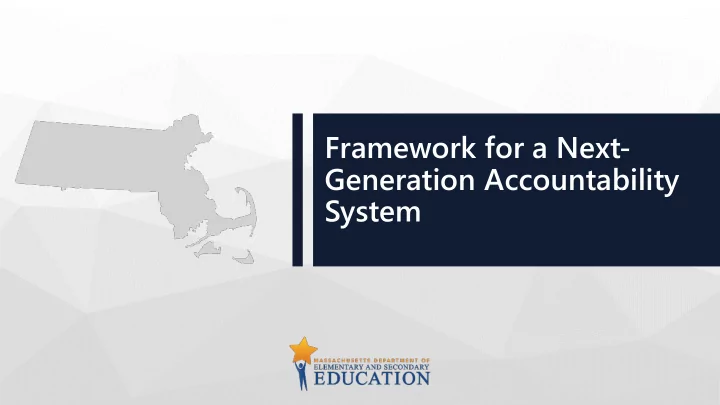

Framework for a Next- Generation Accountability System
01 Accountability design components 02 Relative component – accountability percentile 03 Criterion referenced component – target AGENDA setting 04 Use of subgroup data for accountability 05 Categorization of schools
Accountability system design components • Which indicators will be included? • How will the system incorporate both relative (school percentile) & criterion-referenced (targets) components? • What subgroups will drive an accountability determination versus just having data reported? • How will schools be considered to be meeting targets? • How will schools be categorized? 3 Massachusetts Department of Elementary & Secondary Education
Accountability indicators to be included Indicator Measure(s) Achievement ELA, math, & science achievement values (based on scaled score) • Student Growth Student growth percentile • High School Completion Four-year cohort graduation rate • Extended engagement rate • Annual dropout rate • English Language Progress made by students towards attaining English language proficiency • Proficiency Additional Indicators Chronic absenteeism (all schools) • Percentage of students passing all grade 9 courses (high schools) • Percentage of students completing advanced coursework (high schools) • 4 Massachusetts Department of Elementary & Secondary Education
Relative component – accountability percentile • Accountability percentile calculated using all available indicators for a school • Used to identify the lowest performing schools in the state, & same calculation used at the subgroup level to identify low-performing subgroups in need of targeted support 5 Massachusetts Department of Elementary & Secondary Education
Relative component – accountability percentile • Next-Generation MCAS test allows us to compare all schools, regardless of grade configuration o Separate high school comparison category is transitional & will not be necessary once all schools are administering Next-Generation MCAS tests 6 Massachusetts Department of Elementary & Secondary Education
Criterion-referenced component • Focus on closing the achievement gap by raising the “achievement floor” o Gap-closing can occur as a result of a decline in performance by the high- performing group • In addition to meeting targets for the school as a whole, the performance of the lowest performing 25 percent of students in each school will be measured o Every school has a lowest 25 percent of performers o Identified from cohort of students who were enrolled in the school for more than 1 year o Schools will know who these students are 7 Massachusetts Department of Elementary & Secondary Education
Criterion-referenced component • Targets set for each accountability indicator, for the school as a whole & for the lowest performing 25 percent of students in each school • Points assigned based on progress toward target for each indicator, for both the aggregate & the lowest performing 25 percent of students Exceeded Declined No change Improved Met target target 0 1 2 3 4 8 Massachusetts Department of Elementary & Secondary Education
Criterion-referenced component Example: Non-high school (weighting to be determined) Points assigned Indicator All students Lowest performing students ELA scaled score 3 2 Math scaled score 2 2 Science achievement 2 1 ELA SGP 4 4 Math SGP 3 4 EL progress 2 4 Chronic absenteeism 3 4 Total 19 21 Combined total points (56 possible) 40 Percentage of possible points 71% 0 = Declined · 1 = No change · 2 = Improved · 3 = Met target · 4 = Exceeded target 9 Massachusetts Department of Elementary & Secondary Education
Categorization of schools • Schools will no longer be placed in a vertical hierarchy of levels 1-5 • Number of schools that will be placed into a category based upon a relative standing will be cut in half from previous system o Approximately 90 percent of schools could be categorized based on their own performance against targets • Most schools will have 50 percent of its categorization based on students that have been in the school for at least 2 years • Category labels are primarily tied to the level of required assistance or intervention • Stronger emphasis on schools commended for success 10 Massachusetts Department of Elementary & Secondary Education
Categorization of schools Schools without required assistance or intervention Schools requiring assistance or intervention (approx. 85%) (approx. 15%) Schools of Partially meeting Not meeting Focused/targeted Broad/ recognition Meeting targets targets support comprehensive targets support Schools Criterion-referenced Criterion-referenced • Non-comprehensive demonstrating target percentage target percentage support schools with Criterion-referenced • Underperforming high 50-74 0-49 percentiles 1-10 target percentage schools achievement, • Schools with low 75-100 • Chronically significant graduation rate underperforming improvement, or • Schools with low schools high growth performing subgroups • Schools with low participation Notes: • Category names not finalized • School percentiles & performance against targets will be reported for all schools 11 Massachusetts Department of Elementary & Secondary Education
Other considerations & known issues • ESE will redesign district & school report cards in 2018 o Will include measures of performance/opportunity beyond assessment & accountability results (e.g., discipline rates, availability of art & other non-core courses, school culture/climate, etc.) • 2019 high school assessment transition • Middle/high & K-12 schools o Administering both legacy & Next-Generation MCAS tests • District accountability o Administering both legacy & Next-Generation MCAS tests o Will not be based on designation of lowest performing school 12 Massachusetts Department of Elementary & Secondary Education
Next steps Upcoming discussions • December 19 – Board discussion on system framework • January 12 – Meeting with the Urban Superintendents Network • January 17 – Meeting with the Superintendents Advisory Council • January 23 – Board discussion on system refinements & weighting of indicators • February 27 – Board discussion of proposed amendments to state accountability regulations 13 Massachusetts Department of Elementary & Secondary Education
Recommend
More recommend